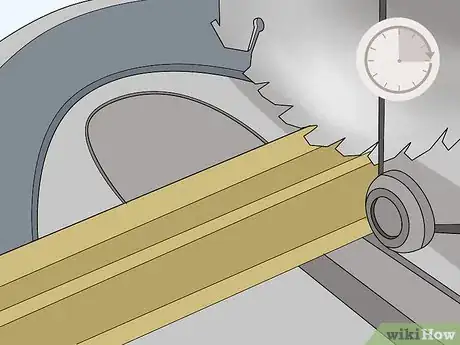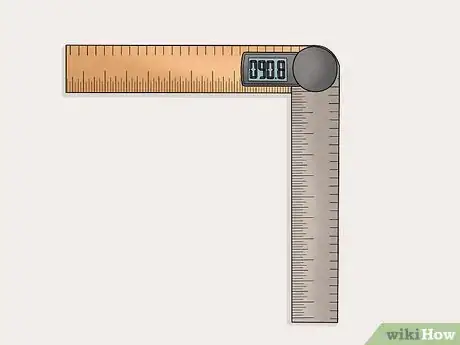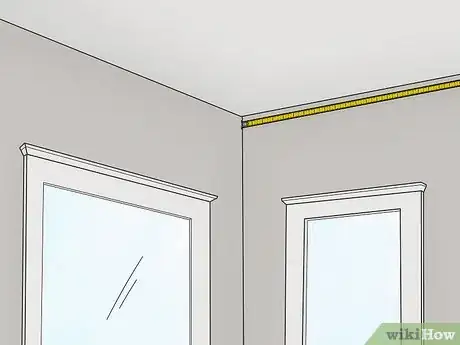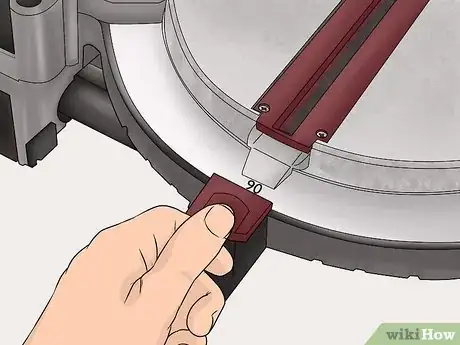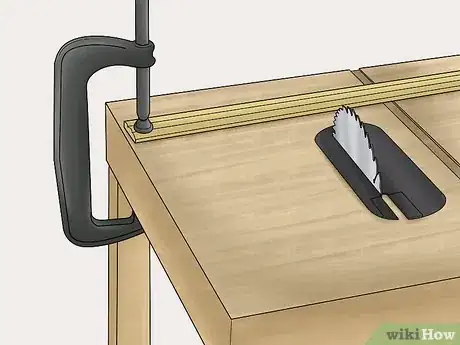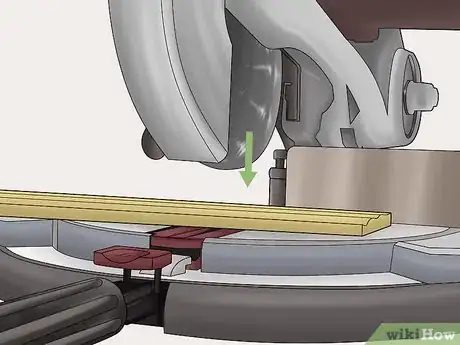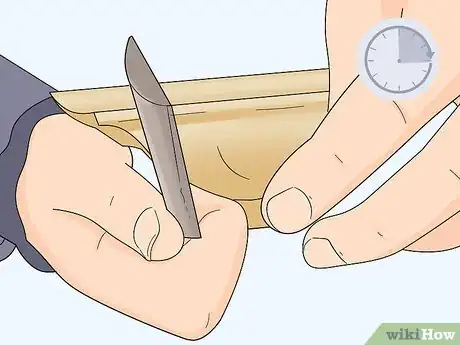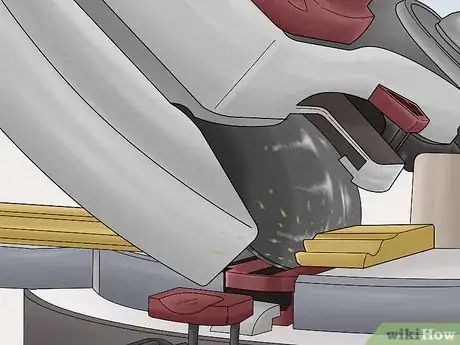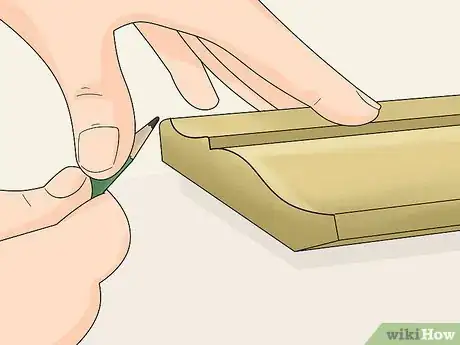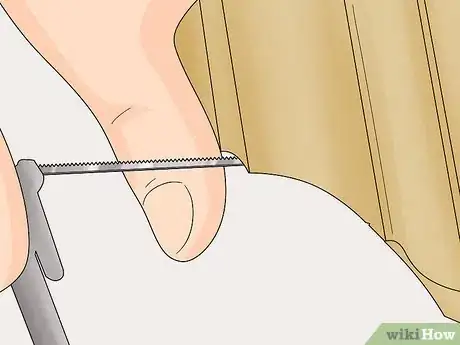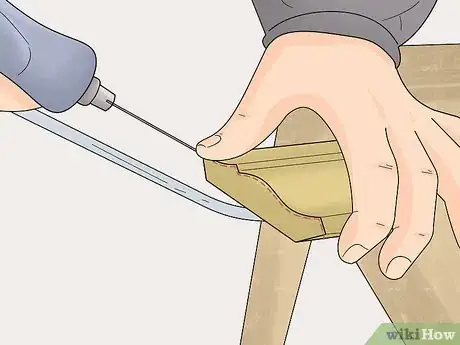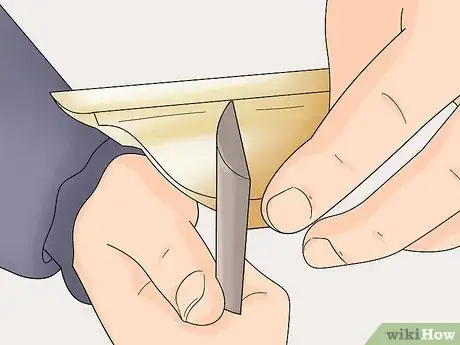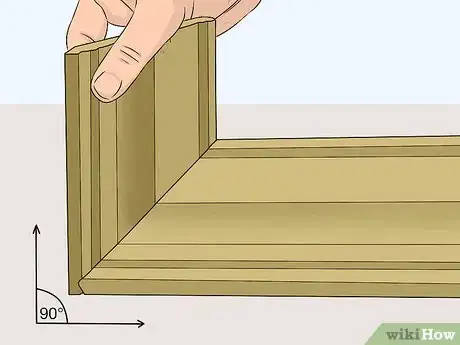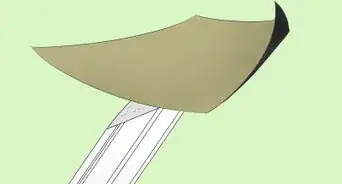This article was co-authored by Alberto DeJesus and by wikiHow staff writer, Eric McClure. Alberto DeJesus is a Construction Specialist and the CEO of DeJesus Industries. With more than four years of experience, he specializes in high-end real estate development and construction. Alberto and DeJesus Industries have been featured on NBC News and have worked with numerous well-known companies, including Mazda, Amazon, and CVS. Alberto holds a Bachelor’s degree from Boston University.
There are 10 references cited in this article, which can be found at the bottom of the page.
This article has been viewed 227,989 times.
There are two ways to cut crown molding for an inside corner. The first method is to cut 2 pieces at an angle and fit them together. This is usually done with a miter saw. This method works best for perfect 90-degree corners where you don’t need to worry about compensating for strange angles. The other option is to cope your corners. This is done by installing one piece of crown molding on top of an uncut piece that sits flush with the wall. To do this, you’ll need to miter one length, then use a coping saw and a file to wear away the wood behind the cut. Coping your corners will result in a tighter fit, but it’s harder to do and requires more work.
Steps
Mitering Joints to Match Equal Cuts
-
1Plan to spend 10-15 minutes mitering your corners. Mitering your crown molding involves cutting each corner at an angle so that the edges fit together perfectly. This involves using an angle finder and miter saw to cut 2 pieces of molding at half of the corner’s angle. However, there will always be a visible seam where the 2 lengths of your molding meet, and you will end up with a gap between the 2 pieces if your cuts aren’t perfect.[1]
- Mitering a corner will typically take 10 minutes per piece, although it may take you a little longer if you’ve never done it before.[2]
- This is a great choice if you know your wall is flat. Place a level along the wall near your ceiling to see if it’s perfectly flat. This method will use 2 angle cuts to fit 2 pieces of crown molding together.
- An inside corner refers to any corner where 2 walls meet at an internal angle, forming a 45-degree angle as you face it. An outside corner is where 2 walls form an external angle, forming a 135-degree angle when you’re facing it.
-
2Use an angle finder to determine the angle of your corner. Place one half of your angle finder against one of your walls. Adjust the other half of your angle finder by moving it with your free hand to place it flush against the adjacent wall. Look at the indicator attached to your angle finder to determine the angle of your walls. Usually, your walls will meet at a 90-degree angle.[3]
- You can use an adjustable protractor or combination square instead of an angle finder if you’d like. There are digital angle finders that make reading the angle easier.
Advertisement -
3Measure your wall and mark the corner you’re going to cut. Use a measuring tape to calculate the length of the wall. Take your crown molding and use the length of your wall to determine where you need to make your bevel cut. Mark the backside and bottom of your crown molding with a pencil to track the location where you’re going to install it in the corner.
- Keep in mind that you need to mark the proper corner based on the orientation. So if you’re installing the right side of the crown molding in the corner, you need to mark the left end on the back and the right side at the bottom.
- A bevel cut is any type of cut made at an angle.
-
4Set up the table of your miter saw to cut at a 90-degree angle. Unlock the rotating table on your miter saw by flipping the handle or pressing the unlock button. Move the handle until your indicator reads 90 or 0, depending on how your table’s guide is designed. As long as the blade is perpendicular to the crown molding, you’re good.[4]
- Even though you’re cutting the joint to fit a 45-degree angle, you still need to cut the piece to fit the length of your wall. You can skip this step if your molding is already cut to size.
- You can use a miter template and a handsaw instead of a miter saw if you’d like. A miter saw template is basically a plastic box with an open top that has slots for a handsaw.
-
5Adjust your blade to cut at an angle based on your wall’s angle. Move the handle on your blade until your indicator matches the desired angle. If your wall is 90 degrees, set your miter saw to cut at 45 degrees. Otherwise, divide the angle of your corner by 2 to determine the angle you need to cut your crown molding.[5]
- Whether you move your blade to the left or right dependent upon what side of the wall you’re cutting for. So if you need the crown molding to meet the inside corner on the right side and you’re cutting from the front, move your blade to the left and vice versa.
-
6Clamp your crown molding in place under the miter saw. Set your molding down in the saw’s table, flush against the fence under your blade. Adjust your crown molding until the cutting line sits flush with the guide line for the blade. Use c-clamps or table clamps to hold your crown molding still by wrapping them around the table and molding before tightening them.[6]
- You can skip the clamps if you’ve got experience with a miter saw. Simply use your nondominant hand to keep the crown molding flush against the fence.
- The fence is the straight edge that you use to keep your material still and lined up.
-
7Lower the saw to make a bevel cut at your desired angle. Take your blade protector off if you have one. Turn your saw on and give your blades 5-10 seconds to get up to speed. Carefully and slowly lower your saw to make your bevel cut. Slide the saw all the way through the crown molding before lifting it up to ensure that your cut is clean. Turn the power on your saw off.[7]
- Wear safety goggles, a dust mask, and gloves to protect yourself from sawdust while you’re cutting. Most miter saws have a built-in catcher for sawdust though, so this shouldn’t be too big of an issue.
- Miter saws are pretty easy to use since the blade is locked in to cut at a specific angle.
Layering Pieces by Coping Them
-
1Plan to spend 10-15 minutes coping your corners. Coping a corner involves installing one piece of crown molding flush with the wall with the second piece laid on top. This is done by mitering one corner and then using a coping saw to cut the wood behind that corner out. Since this method requires the use of a manual tool, it can be kind of tricky to cut the back of each piece out. The seam between the 2 pieces of molding will be cleaner, though.[8]
- The amount of time it takes for you to cope a corner is entirely dependent upon how comfortable you are with a coping saw. For professionals, this may take 10-15 minutes. If you aren’t familiar with a coping saw, this may take you a little longer.[9]
-
2Cut one of your pieces of crown molding to match the angle of your wall. To cope a corner, you’re going to install one piece of crown molding on top of another. The piece on top is the one that you cope to fit on top. Start by using a miter saw to cut one piece at an angle as described in the previous method.[10]
- This is the best method if your walls aren’t perfectly square or your home is older. It’s also more forgiving, since there’s only one cut involved.
- Since you’re not actually matching 2 pieces together, it’s not important that your cut is accurate. You can always make minor adjustments with your file.
- The matching piece does not require coping. You only need to make a perpendicular cut to make it flush with the wall. You can do this with a miter, coping, or circular saw.
-
3Outline the edge of the corner that you’re going to cope in pencil. To ensure that you don’t accidentally remove a piece that you need, take a pencil and run it along the face of your crown molding where it meets the corner. With the edge highlighted, you’ll have an easier time keeping your cuts accurate.[11]
- This will keep you from accidentally cutting into the top of the crown molding. You only need to remove the back.
-
4Clamp your crown molding to your work surface. Take your crown molding and place it on a stable work surface. Adjust the piece so that the edge you’re going to cut is hanging 8–12 inches (20–30 cm) over the edge of your work surface. Use c-clamps or table clamps to hold the crown molding in place by wrapping the clamps around the table and the molding.[12]
- If you’re really experienced with a saw, you can simply hold the molding down with your nondominant hand while you cut.
-
5Cut through the back of your crown molding with a coping saw. With your crown molding secured, place the blade of your coping saw directly under the face of your crown molding. Carefully move the saw back and forth at a 45-degree angle to begin removing the wood behind the molding. Work the saw all the way through your crown molding and remove the wood in the back.[13]
- Your cut doesn’t need to be exact since you’re going to use a file to make your cut flush.
- In other words, you’re cutting towards the center of your crown molding and removing the wood behind it.
-
6Remove most of the wood behind the end that you’re coping. Continue to use your coping saw to cut through the wood. This can be kind of awkward to do since you need to move the saw while you cut. Work slowly and adjust the angle of your saw as needed to trace behind the face of the molding.[14]
- For some people, it’s easier to work in smaller sections by making vertical cuts into the back of the crown molding. This makes the pieces that you’re cutting more manageable.
-
7Use a file to remove the smaller sections near the face of the crown molding. With most of the wood behind the crown molding gone, there is still going to be 1–5 millimetres (0.039–0.197 in) of wood that you can’t accurately remove with your coping saw. To remove this wood, place a file underneath your crown molding. Brace the top of the crown molding with your nondominant hand. Rub the file back and forth along a section until you’ve worn most of the wood away. Repeat this process for every other section that needs to be trimmed.[15]
- Don’t run the file back and forth so quickly that you snap the crown molding. If you do, you’ll need to cut a new piece.
-
8Hold your 2 pieces together to see how the coped joint fits. Coping a joint is more of an art than a science, and you may need to file away more wood. To see how your joints fit, hold your 2 pieces together at a 90-degree angle where you’re installing them. Place the uncut piece underneath the coped joint. As soon as the 2 pieces are flush, you’re done![16]
- If the angle is correct but the joint won’t sit flush, you need to continue to remove wood from the back of your piece.
- Use silicone caulk to fill in any gaps after you’ve installed your crown molding.
Community Q&A
Did you know you can get answers researched by wikiHow Staff?
Unlock staff-researched answers by supporting wikiHow
-
QuestionAt what angle should I cut the molding for a corner?
 wikiHow Staff EditorThis answer was written by one of our trained team of researchers who validated it for accuracy and comprehensiveness.
wikiHow Staff EditorThis answer was written by one of our trained team of researchers who validated it for accuracy and comprehensiveness.
Staff Answer wikiHow Staff EditorStaff Answer
wikiHow Staff EditorStaff Answer -
QuestionWhat kind of saw do I need to cult molding?
 wikiHow Staff EditorThis answer was written by one of our trained team of researchers who validated it for accuracy and comprehensiveness.
wikiHow Staff EditorThis answer was written by one of our trained team of researchers who validated it for accuracy and comprehensiveness.
Staff Answer wikiHow Staff EditorStaff Answer
wikiHow Staff EditorStaff Answer -
QuestionWhat if I need to cut the molding at an unusual angle?
 wikiHow Staff EditorThis answer was written by one of our trained team of researchers who validated it for accuracy and comprehensiveness.
wikiHow Staff EditorThis answer was written by one of our trained team of researchers who validated it for accuracy and comprehensiveness.
Staff Answer wikiHow Staff EditorStaff Answer
wikiHow Staff EditorStaff Answer
Warnings
- Always wear a dust mask, gloves, and protective eyewear when working with power tools.⧼thumbs_response⧽
- Working with a coping saw to make angular cuts can be kind of tough if you don’t have any experience. If possible, practice on a scrap piece of crown molding first to get used to it.⧼thumbs_response⧽
- Make sure that you order some extra pieces of crown molding if you’re installing it yourself. If you mess a cut up, you’ll need to completely replace that piece.⧼thumbs_response⧽
Things You’ll Need
Mitering Joints to Match Equal Cuts
- Angle finder
- Pencil
- Measuring tape
- Miter saw
- Protective eyewear
- Gloves
- Dust mask
Layering Pieces by Coping Them
- Angle finder
- Pencil
- Measuring tape
- Miter saw
- Protective eyewear
- Gloves
- Dust mask
- Coping saw
- File
References
- ↑ https://www.thisiscarpentry.com/2019/03/01/cutting-coping-crown-molding/
- ↑ https://youtu.be/DeLqfGVM-DQ?t=80
- ↑ https://youtu.be/iapio3nkaGQ?t=59
- ↑ https://www.popularmechanics.com/home/how-to-plans/how-to/a4832/4335690/
- ↑ https://www.popularmechanics.com/home/how-to-plans/how-to/a4832/4335690/
- ↑ https://www.popularmechanics.com/home/how-to-plans/how-to/a4832/4335690/
- ↑ https://www.popularmechanics.com/home/how-to-plans/how-to/a4832/4335690/
- ↑ https://www.thisoldhouse.com/how-to/how-to-cope-joint-crown-molding
- ↑ https://www.thisoldhouse.com/how-to/how-to-cope-joint-crown-molding
- ↑ https://www.thisiscarpentry.com/2019/03/01/cutting-coping-crown-molding/
- ↑ https://youtu.be/3MT9iVtiOEY?t=322
- ↑ https://youtu.be/t3v3J1EFrR8?t=44
- ↑ https://www.thisiscarpentry.com/2019/03/01/cutting-coping-crown-molding/
- ↑ https://youtu.be/3MT9iVtiOEY?t=414
- ↑ https://youtu.be/3MT9iVtiOEY?t=488
- ↑ https://youtu.be/3MT9iVtiOEY?t=502
About This Article
To cut crown molding inside corners, start by measuring the angle of the corner using an adjustable protractor, and setting a compound miter saw to the correct angles. Next, place the piece of crown molding in the jig and the bed of your saw to cut the right inside corner. Then, set the miter saw angle again and use another piece of crown molding to cut the left inside corner. Afterwards, fit the 2 pieces together into the corner of the wall and nail them into place. To learn more, including how to fix gaps or excess material in between your pieces of crown molding, scroll down.
